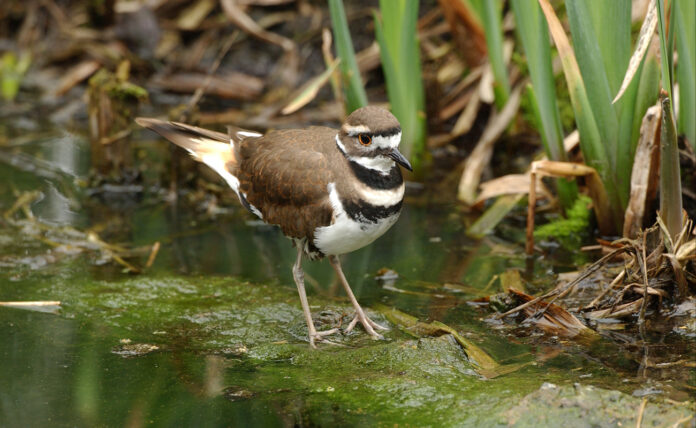
Courtney Brennan was just 8 or 9 when she saw a killdeer in a neighbor’s yard near Cleveland. As she and her friends charged toward it, the bird went into its classic broken wing behavior, dragging one wing on the ground and sounding distressed as it lured the invaders away from the nest.
Going home to watch internet videos and listen to the kill-dee call for which it was named, the little girl was hooked.
“It was very cool and it got my bird interest going,” said Brennan, who is now senior collections manager of zoology at the Cleveland Museum of Natural History, with a specialty in ornithology.
Protect the nest
The killdeers’ broken wing behavior comes in handy considering their nests are more a matter of scratching and scraping in short vegetation, mud flats, even parking lots and gravel roofs.
Their tan-colored eggs with black and brown spots are surprisingly well camouflaged in the rough environments, but the parents may add twigs, pebbles and even seashells to the nest, just for good measure.
In Ohio, killdeer usually raise two broods per year. Usually, they lay their first clutch in April, but if there’s a warm spring, that can sometimes occur in March. Clutches are usually four eggs, though up to seven have been seen, Brennan said.
Killdeer are monogamous, forming pairs before breeding but often maintaining those relationships for several seasons, she said. Both the male and female do the broken wing behavior to protect the nest, and both help incubate the eggs. In addition to keeping them warm in cool weather, they also keep the eggs cool in hot weather by getting the feathers on their bellies wet.
The young can walk out of the nest as soon as their feathers dry, and they can start eating insects on their own immediately. The parents don’t have to feed them, just protect them and guide them to food.
The protective behavior can be seen when the young run for cover under a parent’s wings.
“Some of the cutest pictures are of the young collected under the parent, and you just see a bunch of legs,” Brennan said.
Another cute behavior is the head bobbing, she said. Both the adults and young can be seen walking or running, then stopping and bobbing their heads, perhaps to check for worms or insects they may have scared out of the ground.
The killdeer’s long, pointed wings allow for rapid flight and great maneuverability. Although they often nest at airports — including Cleveland Hopkins and Burke Lakefront — there are not many collisions with planes due to their speed and aerial skills, Brennan said.
Shorebird
The killdeer is part of the plover family and therefore a shorebird. And while they are plentiful on the shores of Lake Erie and adjacent wetlands, they are also distributed throughout Ohio’s 88 counties.
Unlike other shorebirds, they have adapted to both urban and agricultural areas. They start appearing in large numbers in farm fields in February and are often seen following farmers as they plow, looking for insects.
“They’re one of the earlier species to start migrating,” said Laura Kearns, wildlife biologist with the Ohio Division of Wildlife, noting that some pass through Ohio on their way to breeding grounds as far north as the shores of Hudson Bay. “They like open areas and farm fields that have no crops planted yet.”
Killdeer are the most abundant shorebirds in Ohio, and one of the only shorebirds that breed in the state, she said.
During migration, they’re most abundant in the agricultural areas of western and northwestern Ohio, which become stopover areas during migration north or south. Except for mountainous areas, killdeer are widely distributed throughout their range in North America, Kearns said. But like those of other shorebirds, their populations are in decline.
“Shorebirds are in the greatest decline of any bird species,” Kearns said. “Probable causes of the decline include climate change, habitat loss, overhunting in South America, and pesticide exposure.”
Stable
However, the annual Breeding Bird Survey that is done throughout North America suggests that breeding killdeer populations in Ohio have been stable over the last 50 years and may actually be increasing, she said.
Volunteers, birders and biologists like Kearns participate in the surveys between June 1 and July 1. They follow 65 routes through the state, stopping 50 times along each route for three minutes each. They both watch and listen for birds, reporting how many there are, and what species, at each stop.
The data they collect is sent to the U.S. Geological Survey. The agency’s analysis of that data indicates a declining trend in North America’s killdeer populations of about 0.6% a year, while their populations in Ohio seem to be trending up by about 1% per year, Kearns said.
Some killdeer hang out in Ohio through November then migrate to Central or South America, but many choose to winter in the United States. Since they rely on insects, which are not accessible when the ground is frozen or snow-covered, the killdeer that stay in Ohio year-round are more likely to be found in the southern half of the state, Kearns said.
Killdeer are not only the most abundant shorebird in the state but the most tolerant of humans, she said. And they can benefit humans by providing insect control.
But for Brennan, the killdeer cuteness factor that can inspire a young girl to become a scientist specializing in birds is the biggest benefit of all.











